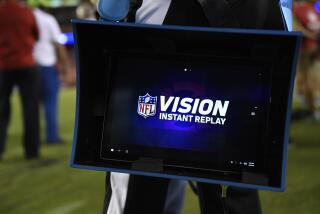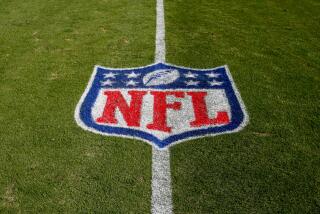Forget concussions. The real risk of CTE comes from repeated hits to the head, study shows
- Share via
For more than a decade, researchers trying to make sense of the mysterious degenerative brain disease afflicting football players and other contact-sport athletes have focused on the threat posed by concussions. But new research suggests that attention was misguided.
Instead of concerning themselves with the dramatic collisions that cause players to become dizzy, disoriented or even lose consciousness, neuroscientists should be paying attention to routine hits to the head, according to a study that examines the root cause of chronic traumatic encephalopathy, better known as CTE.
“On the football field, we’re paying attention to the bright, shiny object — concussion — because it’s obvious,” said Dr. Lee E. Goldstein of Boston University, who led the study published Thursday in the journal Brain. But, he continued, “it’s hits to the head that cause CTE.”
The disease is marked by abnormal deposits of calcium and proteins throughout the brain, as well as by neuropsychiatric symptoms that range from tremors and memory problems to depression and suicidal rage. For now, the only way to diagnose it is by examining a patient’s brain tissue after death.
Some of the hits that cause CTE may result in concussion, Goldstein said. But his team’s findings show that concussion is not necessary to trigger the process.
Indeed, the new research suggests that concussion and CTE are completely different medical problems.
In mice, head impacts that caused concussion and those that led to CTE had different effects inside the brain. In people, the symptoms tend to show up as different behaviors that became evident at very different times. In mice, the research documented immediate behavioral responses to head impact that ranged from zero to disability. And researchers captured what appeared to be the earliest moments of CTE in many mice that showed few if any immediate symptoms.
That new research underscores that the kinds of “sub-concussive” blows to the head that many athletes routinely endure are far more worrisome than players, their parents and their physicians have been led to believe.
Even as football programs from Pop Warner to the National Football League are adjusting their rules to reduce concussions, the findings suggest these efforts will not be enough to prevent long-term injury.
”You have to prevent head impact,” Goldstein said.
The new work originated at Boston University’s Center for Chronic Traumatic Encephalopathy and drew in dozens of experts from a wide range of disciplines and institutions.
The team began by inspecting the brains of four teenage athletes who died one day, two days, 10 days and four months after suffering serious head injuries. Those brains were compared with others belonging to teen athletes who died without a history of head injury.
The researchers observed an abnormal buildup of a protein called tau — a hallmark of CTE — in two of the athletes who experienced head trauma. One, in fact, met the diagnostic criteria for early CTE.
That and other evidence led the researchers to hypothesize that early CTE may result from leaky blood vessels in the brain. In the deep recesses of the organ’s folds, these damaged blood vessels were letting proteins spill into nearby brain tissue, triggering inflammation, they surmised.
To see whether they were right, they needed to study a population of subjects with greater rigor. So they built a machine to deliver calibrated blows to young male mice, subjecting them to a range of head impacts. The effects of these blows were recorded in imaging scanners, in test mazes and on pathology slides.
The researchers examined the animals’ brain chemistry, cortical structure and behavior. Finally, they performed computer simulations to repeat and extend their findings on how various brain tissues responded to head impacts.
The results were all over the map. Delivered a powerful blow, some mice would reel from the injury for days but then recover. Upon dissection, their brains might even look fine.
Other mice, including many who got a series of blows equivalent to participating in a single game or practice, would behave normally in the days following a head impact. But not much later, their brains would reveal early signs of tau protein accumulations.
Sure enough, these deposits appeared to start in the deep recesses of the brain’s folds, where the hallmarks of full-fledged CTE are most clearly seen in humans too.
The results may explain why approximately 20% of athletes who were found to have CTE after they died had never received a concussion diagnosis when they were alive, Goldstein said. And they suggest that people who seem to bounce right back after getting their “bell rung” may well have sustained damage that will not be evident for years.
“The overwhelming majority of people whose brains are hurt are going right back in and doing the worst thing possible: getting hit again and again,” Goldstein said.
The research was presented in New York City in conjunction with a new campaign from the Concussion Legacy Foundation to discourage the participation of kids under 14 in tackle football.
Goldstein and foundation cofounder Chris Nowinski said that playing flag football before the age 14 would reduce injuries to young players while allowing them to learn the game’s fundamentals. They were flanked by NFL Hall of Famers Nick Buoniconti and Harry Carson and Oakland Raiders legend Phil Villapiano.
Nowinski, a former professional wrestler who is now a neuroscientist at Boston University, noted that the U.S. Soccer Federation forbids kids younger than 11 from heading the ball, and that USA Hockey outlawed checking in the sport for kids younger than 13. Youth football leagues should follow that trend, he said.
“Football has been open season on your child’s head from the time they’re allowed to play,” said Nowinski, who was an award-winning defensive tackle during his college days at Harvard.
Goldstein agreed.
“We should be paying attention to all hits,” he said. “And in kids, all the hits should be no hits.”
For some parents and coaches, that may be difficult to imagine. But studies like the one published Thursday should help drive the message home.
“Football coaches are coaching these kids to help them,” Nowinski said. “Their hearts are in right place. They just need to be educated about what scientists are finding. This is really preserving the future for football.”
MORE IN SCIENCE
This new blood test can detect early signs of 8 kinds of cancer
2017 was one of the three hottest years on record, NASA and NOAA scientists say
British government targets a modern public health scourge: Loneliness







